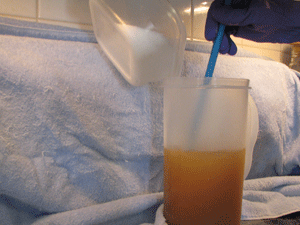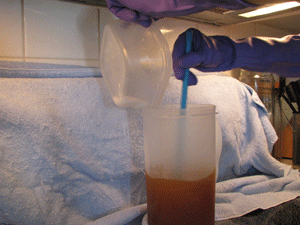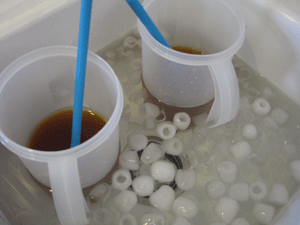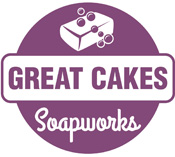How to Make Beer Soap
What is beer soap? Quite simply, it is soap that is made with beer as the liquid instead of water. However, let me say that if you have not made beer soap before, you should be fully prepared. It is not for the faint of heart because you will have to work quickly. You should have quite a few successful batches of cold-processed soap under your belt before attempting this process. In fact, I am not even providing a recipe, only a method. Ok, that’s my disclaimer. You can’t say I didn’t warn you!
After that disclaimer, now let me share WHY you might want to make beer soap. For me, it’s a great marketing hook. I often hear at the market – “Wow! Look at that! Beer soap!” Besides that, beer is also supposed to be a great conditioner for your skin.
Are you ready to get started now? First, you will need to prepare the beer and the oils a full day ahead. Using your regular soap recipe, start by pouring the beer (amount should be 40% of the oils – do NOT discount the liquid) into a plastic pitcher (do NOT use pyrex or glass) and letting it get flat. Really flat. If you have carbon dioxide bubbles, you will have lye bubbles which is really not safe. Once the beer is flat, I recommend boiling it to remove the alcohol, then cool it down in the refrigerator overnight.
The next day you can make soap. Here is my flat, non-alcoholic beer in the plastic pitcher just waiting for the lye to be added:

Now I add my lye EVER SO SLOWLY into the beer. Notice that I am wearing rubber gloves. Always wear your safety gear!!
It will turn a lighter yellowish color and start to stink pretty bad. That’s why I always make my lye solution under the fan under my microwave WHICH VENTS OUTSIDE. I also learned to cover the back of my stove with a towel. It seems that little bits of lye have eaten away some of the enamel finish. Oops. Back to the lye solution. If you pour the lye too quickly, the beer will heat up and cause a volcano. Ask me how I know! Fortunately, it was contained on my glass stovetop…

As the beer continues to heat up, it will turn back to a darker brown.

Once I have all the lye incorporated, I usually put the pitcher(s) in my sink with cold water and ice to speed up the cooling process. I’ve noticed that with a regular lye and water solution, the stink will eventually go away when all the lye has been fully incorporated. Not so much with the beer. In fact, the plastic pitcher will probably carry the smell even after you run it through the dishwasher too. So don’t think you can use it for lemonade when you’re finished making soap. NOT that you would use your lye pitcher for lemonade anyway!!

When the temperature of the lye solution reaches about 85-90 degrees, you’re ready to make soap. I usually use my stick blender for this soap, but you could also use a hand whisk. I just like the smoothness of soap that’s been blended with the electric blender. Not to mention the adrenaline rush of trying to get the soap made before it becomes a brick in your soap pot…

After about two seconds of stick blending, I add a little bit of wheat bran to this batch.

After stirring the wheat bran with my spoon, I add my essential oil blend. I like to stick blend this too just to be sure it’s all mixed in. Just for a few seconds though. Once it starts to thicken, it will set up fast.

Time to pour!

You can see that by the time I have it completely poured, it is really getting thick. I have a few seconds to smooth the top with my spoon, put plastic wrap over it, and cover it with a towel.

I usually cut this soap the next day. Sometimes I have to wait two. It requires a full 4-6 weeks to cure. And it really does NOT smell like beer when it’s all done. In fact, even by the time I cut it, all I can smell is the essential oil blend. Here’s my finished product:

Many thanks to my darling daughter (who will soon be eight) for taking pictures while I made this soap. I couldn’t have done it without her!
Page with Comments
Comments are closed.

Thanks so much for posting. Love the tips and tricks!
thank you for your help on this family project .
Just looking into making beer soap. Thanks for the tips! Really can’t believe your daughter is only eight and took those pictures. I need her at my house!
@Robin – She’s pretty great, all right! And that was 3 years ago, so she’s 11 now. I hope you make some awesome beer soaps!! They really do lather like crazy!
I really like the color of the soap.
Does beer make it that color or do other liquids as well?
would be interested in a recipe tho
thanks for sharing!
@Lyn – I think it’s a combination of the beer and essential oils that make it that color. Patchouli is a deep amber color. You can find all kinds of cold-process recipes at teachsoap.com and just sub beer for the water.
Thanks for the article! My question is: is the beer substituted for the water completely, and the volume of beer used should be 40% of the total volume of oils I use? Thanks!
@Carmen – Yes, the beer is substituted for the water completely, and the volume – by weight! should be 40% of the total weight of the fixed oils in your recipe.
This looks beautiful! You mentioned using a plastic container for the beer, saying not to use pyrex – is there a reason for this? I was just curious because I’ve never used anything else LOL Thanks!
@Annette – Thank you for your comment! Yes, Pyrex can get etched over time by the lye and actually crack. It’s a safety issue!
Do you have this recipe posted anywhere? I’m a newbie and would love some guidance!
@Amber – You can use any cold-process recipe and just substitute the water with beer. There are lots of beginner recipes at teachsoap.com. Best wishes to you!
Do I need to use the same amount of beer as water if I am replacing a current recipe of ours with beer?
@Conchita – Yes, that’s correct. Be sure to use the full water amount – no discounts!
Can this be used with hot process method?
I have heard that Beer soap is great for people with eczema and psoriasis, so I would love to get some for my dad and sister.
I hadn’t heard that, Lori! But you are welcome to purchase my beer soap here: http://www.greatcakessoapworks.com/products/patchouli-beer-handmade-natural-soap
I don’t see why not, Shelby! The process starts out the same when you make your lye solution…
Hi, not sure if this relevant to the conversation but there seems to be a lot of soaping knowledge here. I am confused about this super fat thing. Is the amount of super fat used included in the 100% or do you do your 100% oils and add the % of super fat on top of that? I hope this question made sense. TIA
@Carol – Generally speaking, superfat refers to the percentage of extra fats that have not saponified once the oils and lye have mixed. It’s included in the 100% if you use a lye calculator. You can set the superfat amount to whatever percentage you wish.
Hi! Do you think Hard Cider would give the same lathering effect the beer does? I am allergic to gluten and hops and cannot use beer. Thanks!!
@Krista – Absolutely! Any liquid with a lot of natural sugars is going to give a lot of lather. Be prepared for the soap to set up and heat up fast!
thanks for the info about hard cider, I have problems with gluten too. Wondered what I could use instead. Will try it.
When you say that the beer should be 40% of the oils, what does that mean? Does it mean that I should then put in 40% less of my oils because the beer counts as that 40%? And you’re just putting the exact same amount of beer as you would water. Is this correct?
@Tess – When you are plugging numbers into a soap calculator, the water amount can be measured as a percentage of the oil amount. It is not replacing any of the oils!! And yes, you would be replacing all of the water with flat beer.